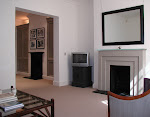When planning furniture layouts I find helpful to create a framework of simple, solid pieces. Clean shapes and good quality are the foundation of a design which will then allow "dressing up" or "down" with accessories. Here are some old favourites, furniture and upholstery design I revisit all the time given their versatile proportions:
Dark, nearly black, stained oak furniture with modernist inspired chunky detailing and proportions



Upholstery, unless you are designing an accent piece, benefits once again from clean shapes (whether including traditional scroll arms or 20th century square detailing)


 The more detailed the piece the more crucial it becomes that quality is impeccable. If budget is an issue, simple choices always pay off.
The more detailed the piece the more crucial it becomes that quality is impeccable. If budget is an issue, simple choices always pay off.
Once a framework of smart pieces of furniture has been created... colour and accessories can be added.
It's a simple recipe but one that will allow future changes without too much disruption.
 In an earlier post you saw a
In an earlier post you saw a  These should give an idea of how a limit on budget does not have to result in a limit on good taste. Stick to your "simplicity" rule across the board. When it comes to fabrics make plainess and budget inversely proportional: the smaller the first the plainer the second! See the board below:
These should give an idea of how a limit on budget does not have to result in a limit on good taste. Stick to your "simplicity" rule across the board. When it comes to fabrics make plainess and budget inversely proportional: the smaller the first the plainer the second! See the board below:  plain fabrics can be of a lesser quality and the difference will hardly be noticeable while patterned fabrics need to be better quality.
plain fabrics can be of a lesser quality and the difference will hardly be noticeable while patterned fabrics need to be better quality.  Through that sketch and photograph the client was able to agree the design and issue his instructions.
Through that sketch and photograph the client was able to agree the design and issue his instructions.  The kitchen, nearly completed, was photographed today.
The kitchen, nearly completed, was photographed today. As you will see the
As you will see the  or
or 
